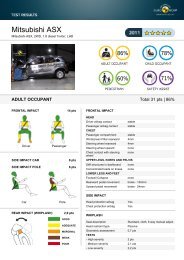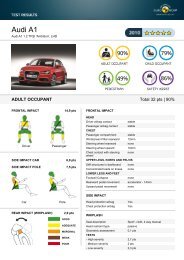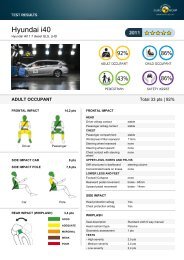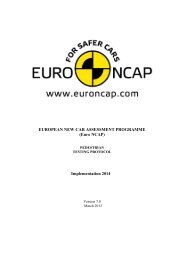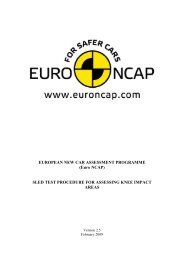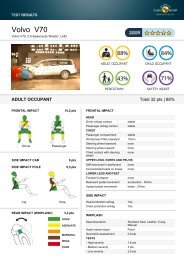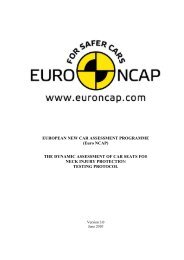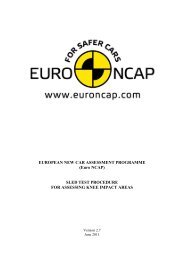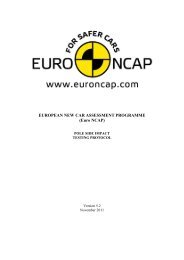Whiplash Testing Protocol - Euro NCAP
Whiplash Testing Protocol - Euro NCAP
Whiplash Testing Protocol - Euro NCAP
Create successful ePaper yourself
Turn your PDF publications into a flip-book with our unique Google optimized e-Paper software.
8 TEST SLED REQUIREMENTS<br />
8.1 Acceleration or deceleration sleds. The dynamic test is intended to simulate a typical rear<br />
crash in which the rear-struck vehicle is initially stationary or moving forward very slowly.<br />
Consequently, an acceleration sled with the dummy seated facing the direction of motion is<br />
recommended for these tests. A deceleration sled, on which the dummy is seated facing<br />
against the direction of motion, and is initially moving rearward at the appropriate test speed<br />
and then stopped, may be used if careful attention is paid to dummy positioning immediately<br />
prior to (T=0). In either case, some sled motion is allowed at the initiation of the test (T=0).<br />
To accommodate different sled types and different relationships between sled motion and the<br />
recording of test data, test time will be indexed as described in Appendix IV. The sled should<br />
not brake before 300ms from T=0.<br />
8.1.1 BioRID positioning requirements for tests using decelerating sled<br />
The dummy‟s head, T1 vertebra, and the sled should have the same velocity ± 0.1m/s at T=0.<br />
The back of the dummy‟s head and T1 vertebra should be in the same position (± 5mm)<br />
relative to the head restraint at T=0 as the initial test set-up. These parameters shall be<br />
checked by the test laboratory from the data outputs, any non-compliance shall be recoded in<br />
the laboratory test report.<br />
8.2 Test time indexing. To normalise the time index among sled laboratory protocols with<br />
different T-zero trigger levels, the time indexing procedure described in Appendix IV shall be<br />
used.<br />
8.3 Laboratory environment. The temperature in the test laboratory should be 22.5º ±3ºC and a<br />
relative humidity of between 10% and 70%. The BioRID test dummy and seat being tested<br />
shall be soaked at this temperature at least 3 hours prior to the test.<br />
8.4 Acceleration pulse. The target sled accelerations and pulse specifications are given in<br />
Appendix IV. Sled accelerations should be measured by an appropriate accelerometer<br />
attached to the sled platform, recorded according to SAE Recommended Practice J211 –<br />
Instrumentation for Impact <strong>Testing</strong> – Part 1 – Electronic Instrumentation. Prior to<br />
establishing conformance with the acceleration pulse specification, any quiescent signal bias<br />
should be removed from the acceleration measurement and the data should be filtered in<br />
accordance with Table 2.<br />
9 TEST SLED INSTRUMENTATION<br />
9.1 Record the X-acceleration of the sled in accordance with SAE recommended practice J211.<br />
The instrumentation should be directly attached to the sled platform and not to any other part<br />
of the test device.<br />
9.1.1 If necessary, remove any data channel DC bias. Typically, the value of the average<br />
measurement over 100 samples of the quiescent data channel signal is subtracted from every<br />
test measurement.<br />
9.1.2 Filter the sled acceleration to channel frequency class in accordance with Table 2.<br />
9.2 The time of dummy head to head restraint first contact shall be recorded with a foil contact<br />
switch.<br />
Version 3.1<br />
June 2011<br />
30



